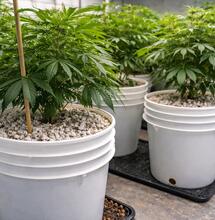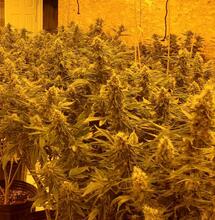Top Tips for Growing Outdoors During Summer

Summer is on the way and one of the most exciting and anticipated times on any grower’s calendar. This is your year to produce some top shelf flower, which will keep your curing cars full to the brim, and give you peace of mind. Below are 9 top tips to help you produce the ultimate outdoor garden this year, and what to consider.
Tip #1: What About Plant Training?
Did you know that there are various plant training methods that can help increase yields? They range from topping, fimming, tying down, snapping stems and pruning foliage. When utilized at the correct times during the vegetative period when plants are only producing foliage and no flowers, then the growth structure and canopy formation can be manipulated and enhanced to be much more productive, or be grown into a more desirable shape.
Our top tip here is to apply at least one of these types of training to your plants, and you will see how each individual strain may act differently. Sativa and taller growing varieties will be well suited for tying down and topping to reduce the final height. Indica dominant cultivars react very well to topping, fimming and pruning.
Tip #2: Watering Times
The hotter it gets means the more your outdoors Cannabis plants will transpire, meaning water is removed from the plants via the leaves much faster. How much water is present in the pots surrounding the root zone, and what is available as water vapor in the air, will determine how they can uptake nutrients and the overall status of their health.
Our top tip here is avoiding watering during the hottest and most uncomfortable parts of the day, and instead adopt a plan, which allows the plants to be watered early morning and early evening time. This method is far more effective than one large watering at the hottest part of the day, and will allow the plants to transpire significantly less and stay in optimal health.
Tip #3: Nutrient Use
The hot and brutal Summer months can really take their toll on Cannabis plants, and especially if there is an imbalance of available nutrients. This will cause plants to use up primary nutrients such as Nitrogen, Phosphorus and Potassium, causing deficiencies to appear.
Our top tip here is to try and work with a combination of organic liquid nutrients and introduce endo-mycorrhizae. The beneficial fungi will attach to the roots of the plants and help them enhance their nutrient uptake and management of available nutrition, as hard food or liquid based.
Tip #4: Why South-facing?
Keeping your plants located in a South-facing location will ensure they receive the most direct light possible each day. The same applies if you are starting seedlings or clones behind a South-facing window. Long flowering cultivars that are more demanding and require longer seasons will also have the best chance when kept South.
Our top tip here is to either plant directly into the ground, if you feel the soil quality is up to scratch. Otherwise, you can always use a 50-100 liter fabric pot and grow an enormous plant that is kept South-facing. The last thing you want to do is have to chase the sun around and keep moving big, heavy pots.
Tip #5: The Neighbors!
Not everyone has good neighbors that they get on well with, or even use Cannabis for that matter. Keeping your closest neighbors happy can be a big difference maker to your anxiety levels as the plants grow and start to throw out some loud terpenes.
Our top tip here is to make sure that your plants are not visible, which can be done using careful planning, plant training and accompanied by companion plants. These plants range from Sunflower, Mint, Clover, Borage, Lavender, Dill, Coriander, and will help protect the plants by repelling insects and adding color and camouflage.
Tip #6: Handling Heat Stress
Anything over 28 degrees Celsius can be stressful for outdoor Cannabis plants. Depending on what the relative humidity levels are, can also play a big role in the overall health and vigor. Sometimes there is nothing we can do about a rising heat wave that can hit over 35 degrees Celsius, but there is one trick you can try.
Our top tip here is to add a shading net that is used to keep the outdoor plants much cooler, during the hottest parts of the day. This can be as simple as a few layers of mosquito netting set over a frame above the plants. You will find the plants will be significantly happier when shaded for 3-4 hours of the day and vibrant than when exposed to blistering heat and high U.V levels.
Tip #7: Insect Damage
There is nothing more demoralizing than finding out your $250 a pack of seedlings has been eaten for lunch by insects at night. A snail or slug may have got the better of your seedlings and clones, and the damage may be slowly but surely killing the plants. If you are beyond the point of no return damage wise, then simply plant new seeds and start again.
Our top tip here is to protect the seedlings or clones by either starting them off inside behind a window that is South-facing. You can also use plastic pint sized cups for the first 7-10 days at nighttime and remove in the mornings. Soft bodied insects cannot breathe when in contact with diatomaceous earth, so this is very useful as a top dressing on the soil. Slugs and snails are repelled by Copper, so invest in some copper wire and make a grid around the pots.
Tip #8: Top Dressing
Overtime, with a strict water only diet, the growing medium can become depleted with organic nutrients. On the basis that there are no liquid nutrients or top dressing used, primary nutrients and trace elements will be quickly used, so it is a good idea to keep the soil food web well-balanced and to ensure there is a solid food supply for the plants while they need to grow as big and wide as possible.
Our top tip here is to use a custom organic blend for top dressing and to have one each for the vegetative and flowering period. For the growing phase, a mixture of worm humus and compost will provide a slow release of N, P, and K as well as Magnesium and other essential trace elements. When flowering starts you can use worm humus, compost and powdered bat guano. Apply a centimeter layer on the top of the soil once a week.
Tip #9: Try Using Clones
Growing with Cannabis seeds can be the easiest way to start a long-winded outdoor crop in Spring time, however for those who may have missed that window of opportunity, using Cannabis clones is just as effective. Once the amount of hours in the day is at the highest point during June and July, then using clones outdoors is not an issue.
Our tip here is to make sure the clones do not start to flower outside and then begin to vegetate again. If you have the timing correct, then the clones will just grow as normal, on par with any seedlings planted. Clones can be a lifesaver, highly practical, easy to source and certified as something tried and tested previously.
Good luck this year with your outdoor gardens!



